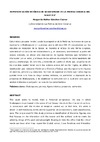Identificador persistente para citar o vincular este elemento:
https://accedacris.ulpgc.es/jspui/handle/10553/47373
| Título: | Representación retórica de Shakespeare en la prensa canaria del siglo XIX | Otros títulos: | Rhetorical representation of Shakespeare in the press of the Canary Islands in the 19th century | Autores/as: | Sánchez Cuervo, Margarita Esther | Clasificación UNESCO: | 6202 Teoría, análisis y crítica literarias | Palabras clave: | Shakespeare Prensa Figura retórica Presencia Comunión, et al. |
Fecha de publicación: | 2015 | Publicación seriada: | Tonos Digital | Resumen: | Este trabajo propone revelar, desde la perspectiva de la Retórica, la manera en que se representa a Shakespeare en la prensa canaria del siglo XIX. En consonancia con los estudios de recepción de la época, se muestra al artista de una forma elogiosa, confiriéndole un aura de ser extraordinario y, en ocasiones, sobrenatural. A partir del corpus utilizado, se ofrece una clasificación de figuras retóricas que fomentan la interacción con el lector, y el deseo de los autores de compartir la visión laudatoria del poeta y dramaturgo. En concreto, y teniendo en cuenta el efecto que las palabras de los cronistas pueden tener sobre los lectores acerca del escritor inglés, se utiliza la clasificación que realizaron Perelman y Olbrechts-Tyteca, que distinguen entre figuras de elección, presencia y comunión. Se trata de expresar el efecto que ciertas figuras pueden tener a la hora de elegir ciertos términos, de aumentar la impresión de la presencia de Shakespeare, y de establecer la comunión con el auditorio para que se sientan inclinados a compartir las tesis de los comentaristas. This paper seeks to reveal, from a rhetorical perspective, the way in which Shakespeare is portrayed in the press of the Canary Islands in the nineteenth century. In accordance with the studies of reception carried out at that time, the artist is shown in commendatory terms and he is grantedan extraordinary, even supernatural, aura. The corpus used for this study provides aclassification of rhetorical figures, one that focuses on the interaction with the readerand the authors’ wish to share the admiringimageof the poet and playwright. Bearing in mind the effect that the critics’ words can have when they regard the English writer, I use Perelman and Olbrechts-Tyteca’s classification, who distinguish among figures of choice, presence and communion. This classification is intent on determining the effect that certain figures can havein the choice of some words, in the increase of Shakespeare’s presence, and in the establishment of communion with the audience so that they feel inclined to share the authors’ theses. |
URI: | https://accedacris.ulpgc.es/handle/10553/47373 | ISSN: | 1577-6921 | Fuente: | Tonos Digital [ISSN: 1577-6921], n. 28, p. 379-394 | URL: | http://dialnet.unirioja.es/servlet/articulo?codigo=4952470 |
| Colección: | Artículos |
Visitas
98
actualizado el 28-sep-2024
Descargas
1.446
actualizado el 28-sep-2024
Google ScholarTM
Verifica
Comparte
Exporta metadatos
Los elementos en ULPGC accedaCRIS están protegidos por derechos de autor con todos los derechos reservados, a menos que se indique lo contrario.
